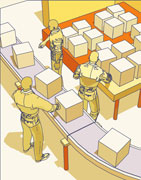Despite the diplomatic and military twists and turns between China and the island of Taiwan, the two countries are fast becoming virtually one in the vital field of information technology. The full extent of this collaboration already is stunning. According to International Data Corp, Taiwanese factories on the mainland make:
• More than 85% of the monitors for the world’s desktop computers.
• More than 90% of all laptop computers.
• More than 70% of the motherboards that house the key components of desktop PCs.
These are just some of the manufacturing links between Taiwan and China, which some observers have taken to calling “Chaiwan”. Also rolling out of Taiwanese plants on the mainland are the Apple iPhones and iPads, Amazon Kindles and Sony PlayStations that consumers around the world are rushing to buy. “Taiwan is becoming more and more an integrated part of the Chinese economy, especially in IT,” notes Dieter Ernst, a senior fellow at the East-West Center in Honolulu. “The speed of change is incredibly fast in both countries.”
This has led to the partial economic unification of the two sides, while leaving the military and diplomatic situations unresolved. Beijing views Taiwan as a breakaway province that it plans to annex, and vows to attack if Taipei claims independence. In Taiwan, President Ma Ying-jeou must walk a fine line between strengthening economic ties with the mainland and appearing to kowtow to Chinese demands — a charge leveled against his Kuomintang Party by the opposition Democratic Progressive Party. Ma thus hews to a policy of “no unification, no independence and no use of force.”
Yet the economic links are joining the two sides closer together. “The reality on the ground is that economic integration is going on, and more and more Taiwanese companies will have to depend on the mainland market,” says Wharton marketing professor Z. John Zhang. As this blending of economies proceeds, “political integration will be a whole lot easier,” although whether that will ultimately take place “is anyone’s guess.”
Zhang sees further signs of a thaw in cross-Strait relations. The two sides now permit direct flights from China to Taiwan, he notes, and Beijing encourages Taiwanese tourists to visit the mainland. At the same time, Chinese universities now accept Taiwanese applicants, and Chinese employers recognize degrees from Taiwan.
A ‘Silicon Shield’
Economic integration may move faster following the landmark Economic Cooperation Framework Agreement that Taiwan and China signed in June. The deal is designed to slash tariffs and boost trade between the two sides. “Cross-strait cooperation is bound to receive a significant boost,” from the agreement, Ernst maintains, since Taiwanese IT companies will face fewer barriers to engaging in joint engineering and research and development projects in China.
Taiwanese firms have accelerated their mainland investments since the election of Ma two years ago. Taipei-approved investments in China nearly tripled to $5.7 billion in the first half of 2010, according to Taiwan’s Ministry of Economic Affairs, with the bulk of the projects going to IT and related industries. Taiwanese companies employ an estimated 14.4 million workers on the Chinese mainland — a figure that equals some 60% of Taiwan’s population of 23 million.
This hefty employment alarms Taiwanese critics of mainland investment, who charge that it is “hollowing out” Taiwan’s industrial sector by exporting jobs to China. In a July editorial, the daily Liberty Times criticized what it called the “unbalanced investment strategy” of Taiwan’s Hon Hai Precision Industries, whose Foxconn Technology Group is the world’s largest contract manufacturer of electronic products from smartphones to computer hardware. Foxconn employs an estimated 800,000 workers in China, the newspaper noted, compared with just 20,000 in Taiwan.
Meanwhile, both countries are struggling to break out of the “commodity trap,” a term for producing low-margin manufacturing for Western companies. “We are trying to find out what the keys are to transforming this culture from a purely manufacturing industry to something more creative and innovative,” says Wen-Jean Hsueh, cofounder and general director of the Creativity Laboratory at Taiwan’s Industrial Technology Research Institute (ITRI), a state-backed incubator of high-tech companies.
Taiwan’s IT sector owes its existence to ITRI, which was founded in 1973 to strengthen the country’s competitiveness. The institute launched the Taiwan Semiconductor Manufacturing Co. (TSMC) a decade later as the personal computer industry was taking off. Today, TSMC is the world’s largest contract chipmaker with a 45% share of the market, according to the Gartner Group. Taiwan’s share jumps to 58% when the country’s United Microelectronics Corp. is included. Some pundits call Taiwan’s semiconductors its “silicon shield” against an attack from China, arguing that the United States would move to prevent any such strike to safeguard U.S. access to the precious chips.
Taiwanese industry entered China in the 1980s to take advantage of the inexpensive labor, land and construction costs there. Investment soared in the 1990s as the demand for IT products boomed around the world.
The very size of Taiwan’s mainland investments creates challenges for Taiwanese companies. A string of nearly a dozen suicides earlier this year focused worldwide attention on conditions at Foxconn’s huge complex in Shenzhen on the coast of southern China. Some 400,000 workers produce Apple iPhones and iPads and numerous other goods at the site. Foxconn subsequently raised wages at the complex and said it would shift some jobs to two new plants that will employ 100,000 workers in Zhengzhou in central China, where labor costs are lower.
The suicides sparked a backlash against Foxconn at home, where critics labeled the deaths “the shame of Taiwan.” That brought Taiwan’s Chinese National Association of Industry and Commerce to the defense of Foxconn’s parent company. “Globalization is the only way out for Taiwan,” the trade group stated, “given the limited size of its economy. It’s not easy for Taiwanese businesses to go global, and too much criticism instead of encouragement would only serve to discourage them.”
A Matter of Inches
Taipei itself has limited some cross-Strait investment for fear of handing China technology that it could use to catch up with Taiwanese manufacturers and perhaps put to military use. This has created a two-steps-forward, one-step-backward approach to transferring technology. To meet the surging Chinese demand for televisions, for example, Taiwan began allowing its companies to make flat-panel, liquid crystal TV screens on the mainland for the first time this year. But Taipei restricts such facilities to technology that is at least one generation behind the flat-panel factories in Taiwan, and thereby limits the efficiency and output of the mainland plants.
The Taiwanese government has kept a similar lid on mainland production of the semiconductor wafers that are used to make computer chips. The wafers come from giant plants called foundries, or “fabs,” that produce micrometer-thin disks of up to 12 inches in diameter — about the size of a medium pizza. The larger the disks the more chips can be created from them, making 12-inch wafers the most cost-effective to produce with current technology
However, Taiwan bars its companies from building 12-inch fabs in China that could compete with semiconductor plants at home. So Taiwan’s TSMC can only add capacity to its 8-inch fab in Shanghai, instead of building a more efficient Chinese foundry. “Our priority for expansion in China is indeed increasing capacity at our facility in Shanghai,” notes J. H. Tzeng, a spokesman for TSMC.
Such restrictions draw fire from the US-Taiwan Business Council, an Arlington, Va.-based trade group that says Taipei’s foot-dragging hobbles the ability of Taiwanese companies to compete with rivals in other countries. Council members include major U.S. firms that do business with Taiwan. The nonprofit group notes that Intel is opening a 12-inch wafer fab in Dalien in northern China, while South Korea’s Samsung Electronics and LG Display announced plans to build flat-panel TV screen plants on the mainland before Taiwan would permit its own companies do so.
The council, chaired by former World Bank President Paul Wolfowitz, now wants Taiwan to draft comprehensive guidelines to encourage technology investment in China. “Since the expiration of the previous guidelines in 2005,” according to a council report, “Taiwan has squandered several years in which its technology companies might have gained critical advantages over their Chinese and South Korean competitors.”
Past incidents have fed Taiwanese concerns about transferring technology to the mainland. TSMC sued China’s Semiconductor Manufacturing International Corp. (SMIC) in U.S. courts in 2005 and 2006 for patent infringement and stealing trade secrets after Taiwanese engineers helped launch the Chinese chipmaker. SMIC granted TSMC an 8% equity stake plus $200 million in cash last year in an out-of-court settlement. SMIC has long struggled to turn a profit and last year lost more than $960 million, while TSMC posted $2.7 billion of net income.
Taiwanese companies have been stronger than their Chinese counterparts in hardware though less successful in software. Lenovo, China’s largest computer maker, acquired IBM’s personal computer division in 2005 to gain an advantage over Taiwan’s Acer. But Acer struck back by acquiring Gateway, a U.S. rival of IBM, in 2007. Acer was the world’s No. 2 PC maker (after Hewlett-Packard) in the first half of 2010, according to Gartner, while Lenovo ranked No. 4. “The thing to notice here is that China’s largest and most high-profile computer company is still losing ground to Taiwan,” suggests Terry Cooke a senior scholar at the Foreign Policy Research Institute in Philadelphia
Taiwan dominates the worldwide market for portable computers through contract manufacturers whose names are little known to the general public. Quanta Computer makes more laptops and laptop hardware than any other company for a client list that includes Hewlett-Packard, Sony, Dell and Apple. Asustek Computer broke out of the contract-manufacturing niche and became a global brand by pioneering netbooks, small and inexpensive laptops.
China has been winning business against Taiwan in the field of software services, an area in which Taiwan continues to lag. “Taiwan has never had anywhere near the strength in software development that it has in hardware,” Cooke notes. “It’s not a real player in that industry.”
397 Patents
Both countries must now upgrade their ability to design and develop trend-setting IT products. “Both in China and Taiwan, investment in research that goes beyond incremental innovation is still insufficient,” the East-West Center’s Ernst states. “And most important, both Taiwanese and Chinese firms have limited portfolios of patents for critical standards” that other companies must follow.
Taiwan’s ITRI is redoubling its efforts to create such intellectual property. ITRI received 397 patents from the United States last year, the most for any research institute. Under ITRI’s leadership, Taiwanese flat-panel makers are developing flexible screens that can roll up or down like window shades and deliver color graphics to the next generation of e-readers.
To help spur innovation, engineers at ITRI’s Creativity Laboratory have joined forces with artists, writers and other professionals to brainstorm new ideas. The laboratory’s mission “is to lead the transformation from ‘Made in Taiwan’ to ‘Created in Taiwan,'” according to a brochure for the facility. “Basically, we started out to encourage everyone to explore the dreams that they want to fulfill,” says lab cofounder Wen-Jean, who holds a doctorate in mechanical engineering from the California Institute of Technology. “What we’re doing now is a lonely effort,” she adds. “There isn’t a commercialized product yet.”
Such a product could boost Taiwan’s competitiveness and add to ties with China. “Taiwan has helped to create a very large IT ecosystem on the mainland that is a win-win for both countries,” Cooke points out. However, he notes, the diplomatic tension between the two countries creates “a kind of static that obscures the economic signal.” Will this static subside? Cooke suspects that it will. “It could be that there just hasn’t been enough time for things to play out” diplomatically, he says. “My personal belief is that one should expect to see some further relaxation.”



